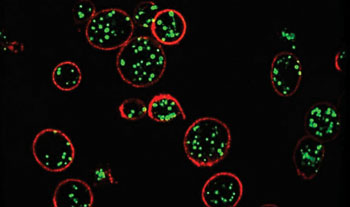Super-Resolution Microscopy Improves Platelet Granule Disorder Diagnosis
By LabMedica International staff writers
Posted on 15 Feb 2016
Platelets or thrombocytes form part of the blood, help heal wounds, and prevent bleeding by forming blood clots and they do this through tiny granules that release molecules for blood clotting. Posted on 15 Feb 2016
Platelet disorders occur when these granules are too few in number, are misshapen, or do not release the right molecules; and as causes for platelet disorders vary considerably, specific treatment can be improved if diagnostic tests can distinguish the different types.

Image: Platelet granules in a blood sample stained for the marker protein CD63 visualized by Structured Illumination Microscopy (Photo courtesy of the University College London).
A team of scientists led by those at the University College London (UK) took blood samples were taken from three patients with Hermansky Pudlak Syndrome and seven controls. The three patients each had a defect in the Hermansky-Pudlak Syndrome 1 (HPS1) gene, HPS6 and HPS5 respectively and all the controls were healthy volunteers. Platelet-rich plasma was isolated from blood and the platelets were fixed, stained for CD63, and processed for analysis by immunofluorescence microscopy, using a Structured Illumination Microscope (SIM).
The imaging technology was custom-built by the team to automatically count the number of granules per platelet, identifying those with Hermansky-Pudlak Syndrome, a rare blood disorder thought to affect 1 in 500,000. The team distinguished the three patients with Hermansky-Pudlak Syndrome from the seven normal controls with 99% confidence. Automated counting of granules showed that those with the disorder had only one third as many granules as controls.
The authors concluded that a super-resolution imaging approach is effective and rapid in objectively differentiating between patients with a platelet bleeding disorder and healthy volunteers. CD63 is a useful marker for predicting Hermansky-Pudlak Syndrome and could be used in the diagnosis of patients suspected of other platelet granule disorders.
David Westmoreland, a doctoral student and first author of the study said, “We've found that SIM has a lot of advantages over whole mount electron microscopy as a diagnostic method. Samples don't need to be analyzed live and can be reanalyzed, and automation means analysis is unbiased and less time-consuming. Given [that] about 75% of patients with a bleeding disorder such as Hermansky-Pudlak Syndrome are initially misdiagnosed and 28% need to see between four to six specialists before receiving the correct diagnosis, there is a demand for a new method of analysis.” The study was published online on January 25, 2016, in the Journal of Thrombosis and Haemostasis.
Related Links:
University College London













